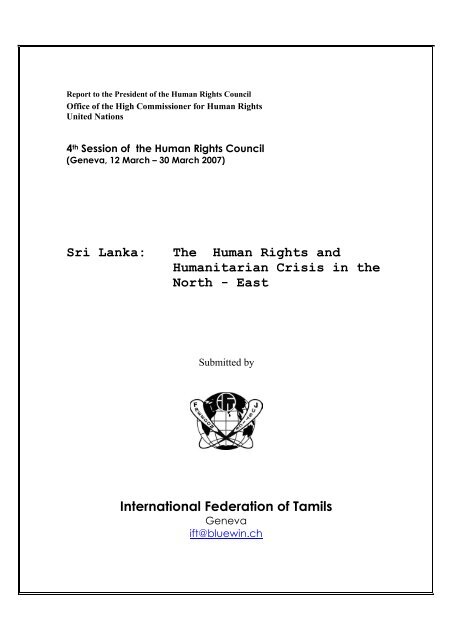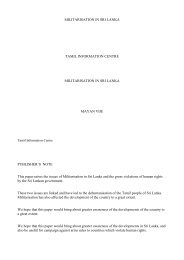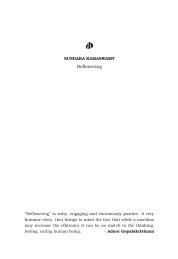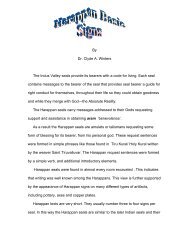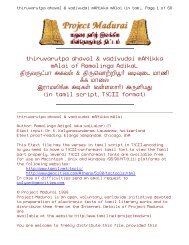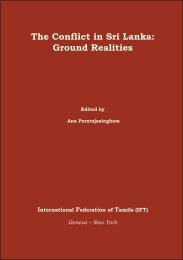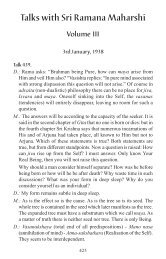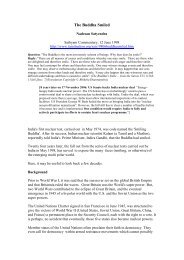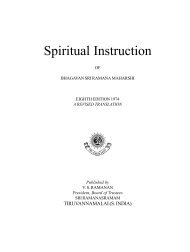in PDF - Tamil Nation & Beyond
in PDF - Tamil Nation & Beyond
in PDF - Tamil Nation & Beyond
You also want an ePaper? Increase the reach of your titles
YUMPU automatically turns print PDFs into web optimized ePapers that Google loves.
Report to the President of the Human Rights CouncilOffice of the High Commissioner for Human RightsUnited <strong>Nation</strong>s4 th Session of the Human Rights Council(Geneva, 12 March – 30 March 2007)Sri Lanka:The Human Rights andHumanitarian Crisis <strong>in</strong> theNorth - EastSubmitted byInternational Federation of <strong>Tamil</strong>sGenevaift@bluew<strong>in</strong>.ch
12 March 2007Sri Lanka: The Human Rights and Humanitarian Crisis <strong>in</strong> the North - EastContents of the ReportA. Introduction…………………………………………………………………………..… page 3* Conflict back ground* The General Situation <strong>in</strong> SLAF Occupied territory* The General Situation <strong>in</strong> the LTTE Adm<strong>in</strong>istrated 'De facto <strong>Tamil</strong>eelam State'B. Human Rights and IHL situation <strong>in</strong> the North-East……………………………………. page 8* Extrajudicial kill<strong>in</strong>gs: "Alarm Is Sound<strong>in</strong>g For Sri Lanka"* Enforced or Involuntary Disappearances: "White vans without number plates"* Gross breaches of International Humanitarian Law* Media under threat* Impunity and SL's promise for <strong>in</strong>vestigationsC. Recommendations ……………………………………………………...…………….. page 19……….IFT Geneva report to the Human Rights Council (12 March 2007) 2
A. Introduction1. In recent statements of the UN High Commissioner for Human Rights(HCHR), the UN Special Rapporteurs and major <strong>in</strong>ternational human rightsNGOs <strong>in</strong>clud<strong>in</strong>g Amnesty International, Human Rights Watch, ICJ,Humanitarian Law project and others have identified Sri Lankan as a 'hotspot'<strong>in</strong> the map of the <strong>in</strong>ternational human rights and humanitarian crisis.2. In the North-East of Sri Lanka, nearly 1500 <strong>Tamil</strong> civilians were killed with<strong>in</strong>the past 15 months, <strong>in</strong>clud<strong>in</strong>g two <strong>Tamil</strong> parliamentarians, with state complicity;Over 900 disappearances were reported <strong>in</strong>clud<strong>in</strong>g a vice chancellor of a <strong>Tamil</strong>University and a Christian priest. The military and para-military violence andretaliatory violence produced tensions between the parties and among thepopulation.3. At the 2nd session of the Human Rights Council (HRCouncil) <strong>in</strong> Aug.2006, theHCHR and others raised the alarm at the <strong>in</strong>creased level of serious violations.Many western countries compare the situation to 'Darfur'. The EU proposed amotion on Sri Lanka. But reasons beyond concerns for human rights andhumanitarian crisis, prevented the 2nd session of the HRC from act<strong>in</strong>g on thisalarm<strong>in</strong>g situation. Aga<strong>in</strong>, the 3rd session of the HRC postponed the EU motionto the subsequent session. The UN and member states supported the SL's yetanother promise of <strong>in</strong>vestigations with <strong>in</strong>ternational observers. Further, theInternational Community (IC) expressed the wish that the <strong>in</strong>ternational concernswould reduce the level of violations <strong>in</strong> the Island.4. Contrary to this expectation, the human rights situation and the breaches of theInternational Humanitarian Laws (IHL) are mount<strong>in</strong>g without any seriousattempts by the SL state to prevent them. The extra-judicial kill<strong>in</strong>gs, arbitraryarrests and detentions, <strong>in</strong>voluntary disappearances and other forms of violations<strong>in</strong>clud<strong>in</strong>g threats to the media are now rampant. The ex-foreign m<strong>in</strong>ister of thecurrent government has described this situation as 'one disappearance <strong>in</strong> every 5hours'.5. This report briefly exam<strong>in</strong>es the situation and submits recommendations.Conflict background6. The conflict <strong>in</strong> SL is nearly 50 years long, <strong>in</strong>clud<strong>in</strong>g 30 years of armed conflict.The <strong>Tamil</strong> people claimed themselves as a nation of people who lost theirsovereignty under the European colonial rule. The British Colonial rulers unifiedthe two major people of the island under a s<strong>in</strong>gle unitary rule <strong>in</strong> 1883. In 1948the British left the Island without address<strong>in</strong>g the concerns of the people exceptfor a constitutional guaranty which was removed later by the S<strong>in</strong>hala state. TheS<strong>in</strong>hala nation, due to its numerical majority, took control of the state power. The‘disenfranchisement’ of a million of up-country <strong>Tamil</strong>s <strong>in</strong> 1949 and the ‘S<strong>in</strong>halaonly act’ <strong>in</strong> 1956 and other forms of structural discrim<strong>in</strong>ation and oppressionhave created a S<strong>in</strong>hala-<strong>Tamil</strong> national conflict <strong>in</strong> the Island.……….IFT Geneva report to the Human Rights Council (12 March 2007) 3
7. The <strong>Tamil</strong> leadership resisted these structural oppression <strong>in</strong> non-violent modesof protest . After a period of resistance, the S<strong>in</strong>hala goverment signed two pactswith the <strong>Tamil</strong> leadership (<strong>in</strong> 1956 and 1967) to provide political space for <strong>Tamil</strong>people <strong>in</strong> state power. But these pacts were unilaterally abrogated by the samegovernments under the pretext of S<strong>in</strong>hala political opposition.8. S<strong>in</strong>ce then, <strong>Tamil</strong> people were subjected to various forms of violent oppression<strong>in</strong>clud<strong>in</strong>g frequent riots. In 1958, 1977 and 1983 large levels of violence wererecorded aga<strong>in</strong>st <strong>Tamil</strong> people. In 1979 the Prevention of Terrorism Act (PTA)was <strong>in</strong>troduced. Further, the Emergency Regulations and special provisions havegiven powers to the armed forces to suppress <strong>Tamil</strong> agitation. In 1983, the 6 thamendment of the SL constitution stripped the <strong>Tamil</strong> people of their democraticright to seek a solution to there political aspirations based on self-determ<strong>in</strong>ation.9. In 1977, the united <strong>Tamil</strong> leadership decided to explore the option of freedomfrom the S<strong>in</strong>hala State. This declaration was overwhelm<strong>in</strong>gly voted by the <strong>Tamil</strong>people <strong>in</strong> the 1977 general election.10. The North-East of the island is the <strong>Tamil</strong> homeland with historical existence. TheIndo-Lanka pact signed <strong>in</strong> 1987 recognized this ‘fact on the ground’, irrespectiveof the planned colonization of S<strong>in</strong>hala settlements <strong>in</strong> the <strong>Tamil</strong> homeland andforcible removal of <strong>Tamil</strong> people from the eastern part of the Island.11. In the mid-70s, the <strong>Tamil</strong> armed resistance movement, Liberation Tigersof <strong>Tamil</strong> Eelam (LTTE), was formed with the objective of a solutionbased on self-determ<strong>in</strong>ation. In the 80s, the LTTE grew <strong>in</strong>to a nationalliberation movement. It participated <strong>in</strong> negotiations with the GoSL andregional/<strong>in</strong>ternational players. In the 90s a de-facto state started to evolve<strong>in</strong> the LTTE-controlled areas. In 2002, the GoSL and LTTE signed aCease-Fire Agreement.The Pre-CFA Human Cost of the War12. In this six decade-long national oppression and conflict, 65000 deaths have beenreported. The economic cost and other lost opportunities have been estimated bydifferent agencies. A recent study (released <strong>in</strong> 2005) by the North-EastSecretariat On Human Rights (NESOHR) records 35323 civilian deaths <strong>in</strong> theNorth-East alone between 1974 and 2004. This report does not <strong>in</strong>clude the<strong>Tamil</strong>s killed <strong>in</strong> other parts of the island or the victims who did not have relativesto report the death. In this survey, nearly half of the victims were shot dead.Another 25 percent were killed by <strong>in</strong>discrim<strong>in</strong>ate shell<strong>in</strong>g. Nearly 3500 civilianswere killed <strong>in</strong> the SLAF’s direct air attacks on the civilian population.Cease-Fire Agreement (CFA)13. The prelude to the cease-fire and peace talks facilitated by Norway commenced<strong>in</strong> the late 1990s. In the Year 2000, the LTTE leader received the Norwayrepresentatives <strong>in</strong> Vanni and unilaterally declared a cease-fire, thus creat<strong>in</strong>g anatmosphere conducive to peace talks. Sri Lanka refused to accept this cease-fire.In 2001, after some military disasters at the Northern war front and KatunayakeAir Force base, the GoSL agreed for a cease-fire. In February 2002, both partiessigned a Cease-Fire Agreement.……….IFT Geneva report to the Human Rights Council (12 March 2007) 4
14. The parties engaged <strong>in</strong> direct peace talks <strong>in</strong> different world capitals. But thedisagreement and different agendas of the Sri Lankan State, InternationalCommunity and LTTE, led to a collapse of these talks.15. In 2005, a ‘hardl<strong>in</strong>er’ president Mah<strong>in</strong>da Rajapaksa won the election on a S<strong>in</strong>halanationalist agenda and this has contributed to the serious collapse of the CFA.16. In April 2006, the SL air force grossly breached the CFA and started to attackLTTE-controlled areas by air. In July 2006, the SL armed forces started the firstmilitary offensive action aga<strong>in</strong>st LTTE forces <strong>in</strong> Mavilaru under the pretext ofwater supply, which was later declared by the former Head of the SLMM as ‘notthe true reason’.The General Situation <strong>in</strong> SLAF Occupied territory17. Parts of the districts of Jaffna, Mannar, Vavauniya. Tr<strong>in</strong>comalee, Batticalao andAmparai. are SL military-occupied parts of the <strong>Tamil</strong> homeland. The SLAFcaptured new territories <strong>in</strong> Tr<strong>in</strong>comalee -east and Batticalaoa /Vaharai.18. It has been estimated that over 100 000 Sri Lankan armed forces are occupy<strong>in</strong>gthese regions. The Police and para-military forces are part of this militaryoccupation. The <strong>Tamil</strong> para-military arm of the SLAF is very active <strong>in</strong> theseoccupied territories: the Karuna group <strong>in</strong> the east, PLOTE <strong>in</strong> Vavuniya andEPDP <strong>in</strong> Jaffna.19. The Emergency Regulations, with the recently added provisions of the PTA havebeen extensively used <strong>in</strong> these territories. The courts and police system havebeen weakened ow<strong>in</strong>g to control by the SLAF. This has led to a serious humanrights crisis <strong>in</strong> these occupied areas.20. About 600 000 people who are liv<strong>in</strong>g <strong>in</strong> Jaffna district have been deniedthe freedom of movement ow<strong>in</strong>g to the closure of the A-9 land route by theSLAF. The <strong>Tamil</strong> parliamentarians accused the state of us<strong>in</strong>g the people ashuman shields. This closure is a gross violation of the CFA and other<strong>in</strong>ternational treaties to which SL is a signatory.21. The Sri Lankan Defense M<strong>in</strong>istry and Military heads of the SLAF have promisedto cont<strong>in</strong>ue their offensive actions <strong>in</strong> North East of the Island, irrespective of theconcerns of CFA and IDP crisis.The General Situation <strong>in</strong> the LTTE Adm<strong>in</strong>istrated‘De facto <strong>Tamil</strong>eelam State’22. The CFA recognizes (under the section “Separation of Forces”) the LTTEcontrolledterritory, with l<strong>in</strong>e of control. This territory <strong>in</strong>cludes Mullitivu andKill<strong>in</strong>ochi districts, part of the Jaffna pen<strong>in</strong>sula, Mannar, Vanni (<strong>in</strong> the North);and Tr<strong>in</strong>comalee, Batticaloa and Amparai (<strong>in</strong> the East).23. In this territory, a separate civil adm<strong>in</strong>istrative structure has been put <strong>in</strong> placeunder the political direction of the LTTE leadership. Kristian Stokke, aNorwegian scholar, exam<strong>in</strong>es this situation and remarks that "Sri Lanka’s thirdEelam War created a political-territorial division of the island with a resultantdual state structure <strong>in</strong> the North-East. In the context of the 2002 CeasefireAgreement and based on earlier <strong>in</strong>stitutional experiments, the LTTE is currentlyengaged <strong>in</strong> a comprehensive process of state build<strong>in</strong>g with<strong>in</strong> the areas theycontrol."……….IFT Geneva report to the Human Rights Council (12 March 2007) 5
24. A member of an Australian local parliament, Ms Virg<strong>in</strong>ia Judge, who visited thisde facto entity stated, “ I observed that <strong>in</strong> a remarkable three-year period the<strong>Tamil</strong>s developed a virtual state with<strong>in</strong> the north and north-east of Sri Lanka. Ivisited their judiciary and court, school of law, police station, police academy,medical and technical colleges and small <strong>in</strong>dustries, a community bank plus achildren's home hous<strong>in</strong>g 278 children left orphaned by the war and the recenttsunami. The <strong>Tamil</strong> Rehabilitation Organization (TRO) runs a variety ofdevelopment, relief and reconstruction projects as well as assist<strong>in</strong>g several nongovernmentorganizations with their projects. All this is a tribute to the spirit andresilience of the <strong>Tamil</strong> people. " (<strong>in</strong>terview dt.sept.2005)<strong>Tamil</strong>eelam Penal Code25. The head of the judicial department Mr.Pararajas<strong>in</strong>gham offers the follow<strong>in</strong>gexplanation: “Dist<strong>in</strong>guished <strong>Tamil</strong> jurists, legal experts and lead<strong>in</strong>g lawyersstudied the British, Indian and Sri Lankan crim<strong>in</strong>al justice systems beforeformulat<strong>in</strong>g the <strong>Tamil</strong> Eelam Penal Code. We have identified 439 types ofcrimes. Some crimes considered liable for punishment <strong>in</strong> the Sri Lankan PenalCod are treated less harshly <strong>in</strong> our Code. We are <strong>in</strong> the process of review<strong>in</strong>gprovisions <strong>in</strong> the penal code that permit capital punishment <strong>in</strong> the light of the<strong>in</strong>creas<strong>in</strong>g <strong>in</strong>ternational trend aga<strong>in</strong>st it. However, until such time anyonesentenced to death can petition the Review Committee seek<strong>in</strong>g pardon.“There are six district courts – <strong>in</strong> Kil<strong>in</strong>ochchi (Jaffna and Kil<strong>in</strong>ochchi Districts),Mallavi (for the Vavuniya District), Jeyapuram (Mannar District),Puthukkudiyiruppu (Mullaithivu District), Tr<strong>in</strong>comalee and Batticaloa. Eachcourt has a Family Counsell<strong>in</strong>g Unit. There are two high courts – one <strong>in</strong>Kil<strong>in</strong>ochchi and the other is Mullaithivu. The Thamil Eelam courts have heard24000 cases and delivered judgments on 20000 so far – that is s<strong>in</strong>ce they werefirst established ten years ago. There is an appeal court <strong>in</strong> Kil<strong>in</strong>ochchi and wehave created a ‘Special Bench’ to hear cases rejected by the Appeal Court. Wehave also established a Review Committee on Appeal for Pardon to which thosewho have been sentenced to death can have recourse.” He further expla<strong>in</strong>s: “Weare endeavour<strong>in</strong>g to <strong>in</strong>troduce progressive laws relat<strong>in</strong>g to women. We broughtan amendment to the penal code <strong>in</strong> connection with abortion. Earlier it waspermissible on medical or other reasonable grounds only with the consent of bothhusband and wife. Under the said amendment a woman can take the decision onher own to abort her pregnancy with<strong>in</strong> five months of conceiv<strong>in</strong>g on medical orother reasonable grounds”. (Interview with Pararajas<strong>in</strong>gham dt.30.10.2003).<strong>Tamil</strong>eelam Police Force26. The Police force of <strong>Tamil</strong>Eelam is responsible for ma<strong>in</strong>ta<strong>in</strong><strong>in</strong>g law and order <strong>in</strong>this area. The head of the <strong>Tamil</strong>Eelam police stateX, “Serious crime <strong>in</strong> areasunder our control is low. We ma<strong>in</strong>ly deal with compla<strong>in</strong>ts of theft, domesticdisputes <strong>in</strong>clud<strong>in</strong>g land, property matters. Enforc<strong>in</strong>g strict traffic laws to conta<strong>in</strong>traffic accidents and fatalities has become a recent priority. As a people’s forcewe are also <strong>in</strong>terested <strong>in</strong> social development of our community. Rights ofWomen and Children are of <strong>in</strong>creas<strong>in</strong>g concern to us and that is why we haveopened a special division to address issues related to sexual harassment, domesticviolence aga<strong>in</strong>st children and other related matters. Our zero-tolerance policy on……….IFT Geneva report to the Human Rights Council (12 March 2007) 6
ibery and corruption has earned the trust and respect of our people, and this hashelped <strong>in</strong> the efficient execution of our duties.” (Interview with Nadesan, Headof the Police force)27. The ICRC makes regular visits to the 3 prisons and 17 police stations <strong>in</strong> this defacto state. Local and <strong>in</strong>ternational human rights advocates and officials engagewith the local police and judicial and prison system, to improve the quality of theservice.……….IFT Geneva report to the Human Rights Council (12 March 2007) 7
B. Human Rights and IHL situation <strong>in</strong> the North-EastExtra Judicial kill<strong>in</strong>gs: "Alarm Is Sound<strong>in</strong>g For Sri Lanka"1. Special Rapporteur on extrajudicial, summary or arbitrary executions Professor PhilipAlston addressed the United <strong>Nation</strong>s General Assembly (Third Committee, 20 October2006) on the alarm<strong>in</strong>g situation <strong>in</strong> Sri Lanka. He states, “Today the alarm is sound<strong>in</strong>gfor Sri Lanka. It is on the br<strong>in</strong>k of a crisis of major proportions. Sadly, the worldseems to th<strong>in</strong>k that the dramatic attacks of recent days and the spirall<strong>in</strong>g number ofextrajudicial executions are just one more episode <strong>in</strong> a long-runn<strong>in</strong>g saga”.2. In SLAF-occupied areas <strong>in</strong> North-East and Colombo have reported the <strong>in</strong>creas<strong>in</strong>gnumbers of extra judicial kill<strong>in</strong>gs. S<strong>in</strong>ce Nov.2005 when the new President took thecommand, till the end of Jan2006 (pre-talks on Geneva – 1) and from April 2006 to date,large numbers of civilian kill<strong>in</strong>gs have been recorded by the local and <strong>in</strong>ternationalagencies and the media.3. The civilian-based organisations <strong>in</strong> the North-East estimate that over 1500 civilians werekilled with<strong>in</strong> the last 15 months. These <strong>in</strong>clude two elected <strong>Tamil</strong> representatives, priests,several journalists and media staffs, academics, children and Women. The SLMM,European monitors to the CFA <strong>in</strong> Sri Lanka, confirmed this high numbers of civiliankill<strong>in</strong>gs.4. The judicial authorities <strong>in</strong> Vavuniya <strong>in</strong>formed the head of the supreme court of SL that <strong>in</strong>January and February 2007, 75 extra-judicial kill<strong>in</strong>gs were reported <strong>in</strong> Vavuniya districtalone and 50 among them were civilians. In Manner civilian sources recorded 55 civiliandeaths <strong>in</strong> the same period.5. Accord<strong>in</strong>g to the Colombo-based Civil Monitor<strong>in</strong>g Committee, over 24 <strong>Tamil</strong> civilianswere abducted and killed by the SLAF-backed para-military forces <strong>in</strong> Colombo.6. The data released by the Peace Secretariat of the LTTE follows;December 2005 – February 2006 103March - May 2006 207June – July 2006 134August 2006 363September 2006 114October 2006 65November 2006 47December 83January 2007 86February 2007 66TOTAL 1268……….IFT Geneva report to the Human Rights Council (12 March 2007) 8
23.12.057. The massacres <strong>in</strong> Mannar, Tr<strong>in</strong>comalee, Jaffna, Amparai and Batticaloa districts andother places have terrorised the civilian populations. Apart from kill<strong>in</strong>gs result<strong>in</strong>g fromaerial bomb<strong>in</strong>g and shell<strong>in</strong>g, the number of IHL-l<strong>in</strong>ked human rights violations havereached the attention of the local human rights groups, <strong>in</strong>clud<strong>in</strong>g below listed cases.4 civilians (<strong>in</strong>clud<strong>in</strong>g a 4 year child) burnt to death , at the “Hundredhouses” hous<strong>in</strong>g scheme - MannarSL Navy24.12.05 5 local night workers shot and killed near Jaffna Fort military zone SL Army17.01.06 5 <strong>Tamil</strong> students killed <strong>in</strong> Tr<strong>in</strong>comalee SL STF08.04.06 5 civilians shot dead at Puthur Military camp, Jaffna SL Army12.04.06 12 hack to death <strong>in</strong> Tr<strong>in</strong>comaleeS<strong>in</strong>halasettlers07.05.068 temple workers sleep<strong>in</strong>g overnight at the Kelathu Amman temple <strong>in</strong>Chavakachcheri <strong>in</strong> Jaffna were shot and killedSL Army04.05.067 civilians travell<strong>in</strong>g <strong>in</strong> two three-wheelers were shot and killed at SL ArmyNav<strong>in</strong>dil<strong>in</strong>telligence13.05.06 13 civilians, two of them children, were killed SL Navy08.06.06 Family of 4 hacked to death <strong>in</strong> Vankalai <strong>in</strong> Mannar SL Navy17.06.06 6 civilians shot and killed at Pesalai, Mannar SL Navy05.08.06 17 ACF French aid agency workers shot and killed <strong>in</strong> Tr<strong>in</strong>comalee SL Navy25.08.06 5 mason workers shot and killed at Navatkerny, BatticaloaSL TaskForces29.08.06 10 civilians killed at Puvarasankulam Vavuniya SL Airforce16.09.06 10 Muslim workers were killed at Potuvil SL Airforce29.08.06The SLAF produced 10 bodies and accused that victims were tried toattack the puvarasankulam military base <strong>in</strong> Vavuniya. The localmember of parliament compla<strong>in</strong>ed that they were miss<strong>in</strong>g civiliansfrom that district.SL Army……….IFT Geneva report to the Human Rights Council (12 March 2007) 9
8. Several <strong>Tamil</strong> Political and Civilian Leaders and journalist were killed <strong>in</strong> this period of theworst human rights crisis. Some of the cases are as follows;Mr. Joseph Pararajas<strong>in</strong>gamMr.Raviraj NadarajaMr. V. VigneswaranMember of ParliamentMember of ParliamentMember of Parliament25.12.2005 at the X’mas midnightmass, by the SL assisted militarypersonnel <strong>in</strong> Batticaloa. (The names ofthe suspect was given to the Presidentby the TNA parliamentary group, butno actions taken to date)10.11.2006 Mr.Raviraj was killed <strong>in</strong>Colombo <strong>in</strong> broad day light, <strong>in</strong> a highsecurity zone.07.04.2006 – Mr. Vgneswaran, a<strong>Tamil</strong> leader and newly appo<strong>in</strong>tedMember of Parliament was shot andkilled <strong>in</strong> a high Security zone <strong>in</strong>Tr<strong>in</strong>comalee.Mr. A.SenthilnathanTNA Political leader26.04.2006 – Mr. Senthilnathan, ATNA political leader vavuniya waskilled.Mr.K.SithravadivelPresident of the fisheriessociety27.07.2006 Mr.K.Sithravadivel wasshot dead by the SLAFPerpetrators of the crimes9. Most of the extra-judicial kill<strong>in</strong>gs have been committed by the SLAF and its Para militarygroups like the EPDP (the leader of this group is a cab<strong>in</strong>et member of the current GoSL)and Karuna Group.10. The Chief of the Sri Lankan Army (SLA) Lt. Gen.Fonska is one of the ‘accused’ <strong>in</strong> thekill<strong>in</strong>gs <strong>in</strong> Jaffna <strong>in</strong> the mid-90s. With absolute impunity, he reached the top job <strong>in</strong> theSLA . It is widely believed that under his overall command, the SLA <strong>in</strong>telligence w<strong>in</strong>gtook the law <strong>in</strong>to its hands.11. The dangerous development <strong>in</strong> this period is the crimes committed by the <strong>Tamil</strong> paramilitaryforces <strong>in</strong> the North-East and Colombo. The GoSL refused to acknowledge theexistence of these forces <strong>in</strong> their occupied areas and denied the complicity of the SLAFwith the para-military crimes. This poses a serious threat to the security of the people.One MP was shot and killed <strong>in</strong>side a Church (by the Karuna Group); another was killed<strong>in</strong> Colombo (by the EPDP); one senior leader was killed <strong>in</strong> the high security zone (by thekaruna group). None of the cases has been <strong>in</strong>vestigated and no arrest reported by the SLstate agencies.……….IFT Geneva report to the Human Rights Council (12 March 2007) 10
12. Accord<strong>in</strong>g to a <strong>Tamil</strong> human rights project done by a US-based researcher, 1198 cases ofextra-judicial kill<strong>in</strong>gs were committed s<strong>in</strong>ce 19 Nov.2005 till 01 of Dec.2006. 703 crimeswere committed by the SLAF, 366 by the para-military groups like Karuna group andEPDP. 23 crimes were aga<strong>in</strong>st the forces associated with LTTE and the perpetrators of105 kill<strong>in</strong>gs were not identified.13. The LTTE was accused of some retaliatory kill<strong>in</strong>gs of associates and ‘<strong>in</strong>formants’ of thepara-military forces <strong>in</strong> the SLAF occupied areas.Enforced or Involuntary Disappearances: “White vans without number plates”14. Sri Lanka is ‘notorious’ for its records on disappearances s<strong>in</strong>ce the late 80s. The UNsystem ranked Sri Lanka after Iraq under Saddam Husse<strong>in</strong>, <strong>in</strong> the world list of‘disappeared’.15. Accord<strong>in</strong>g to the Report of the Work<strong>in</strong>g Group on Enforced or InvoluntaryDisappearances (A/HRC/4/41) “In the past and dur<strong>in</strong>g the year under review, theWork<strong>in</strong>g Group has transmitted 12,319 cases to the Government; of those, 40 cases havebeen clarified on the basis of <strong>in</strong>formation provided by the source, 6,530 cases have beenclarified on the basis of <strong>in</strong>formation provided by the Government and 5,749 cases rema<strong>in</strong>outstand<strong>in</strong>g”.16. Accord<strong>in</strong>g to the Jan.2007 report of the Work<strong>in</strong>g Group on Enforced or InvoluntaryDisappearances, ‘it is gravely concerned at the <strong>in</strong>crease <strong>in</strong> reported cases of recentenforced disappearances occurr<strong>in</strong>g primarily <strong>in</strong> the north-east of the country <strong>in</strong> thecontext of renewed fight<strong>in</strong>g <strong>in</strong> the region’.17. The Colombo-based <strong>Tamil</strong> daily Th<strong>in</strong>akural(13.01.07) published a report obta<strong>in</strong>ed fromthe Sri Lanka national human rights commission (NHRC) sources, that 978 cases ofdisappearances were reported <strong>in</strong> the island <strong>in</strong> the year of 2006, 850 cases be<strong>in</strong>g fromNorth East of the Island. In most cases, the victims were kidnapped by un-identifiedarmed persons <strong>in</strong> SLAF-controlled areas.18. The AFP report of 03.02.07 reads: ‘Some 75 ethnic <strong>Tamil</strong>s are believed to have beenabducted by unknown gunmen from militia groups s<strong>in</strong>ce January 1, 2007, a Sri LankanHuman Right Commission officer said’.19. In Jaffna district, the regional branch of the SL national human rights commissionreleased the statistics of 584 disappearances <strong>in</strong> the year 2006 <strong>in</strong> the district. Thecommission could not solve 416 cases. In 128 cases of disappearances, the office hascompla<strong>in</strong>ed of the direct participation of the SLAF.20. In the 12 th Jan.2007 edition, a local <strong>Tamil</strong> daily <strong>in</strong> Jaffna, reported that ‘17 aredisappeared with<strong>in</strong> 9 days’ <strong>in</strong> Jaffna. Among them 5 were taken from their homes; onestudent disappeared on his way back home from private tuition. On 29 th of Dec.06,another local daily published a report of 10 youths disappeared with<strong>in</strong> 6 days.21. On 20 aug.2006, Rev. Fr.Thiruchchelvan Nihal Jim Brown was disappeared at a checkpo<strong>in</strong>t of the Sri Lankan Navy. The Jaffna Bishop and International Christianorganisations and human rights organisations pleaded to the SLAF to f<strong>in</strong>d out the victimand release them. To date, the SLAF has not produced any reasonable explanation on thisdisappearance. (ref. with AI <strong>in</strong>dex: ASA 37/023/2006).22. In Dec.2006, the Civil Monitor<strong>in</strong>g Committee (CMC), released a report of 47 cases ofdisappearances <strong>in</strong> Colombo with<strong>in</strong> 10 months, the capital of Sri Lanka. In these cases, 12victims returned home and the rest are still miss<strong>in</strong>g.……….IFT Geneva report to the Human Rights Council (12 March 2007) 11
23. The Vice-Chancellor of the Eastern university, Professor S.Raveendranath wasabducted by the suspected Karuna group <strong>in</strong> broad day light <strong>in</strong> Colombo on 15 Dec.2006.The family of the victim and International agencies <strong>in</strong>clud<strong>in</strong>g AI pleaded for his release.The Family approached the diplomatic community <strong>in</strong> Colombo to put pressure on thestate to release the professor. (AI <strong>in</strong>dex: ASA 37/035/2006)24. Accord<strong>in</strong>g to the records of the LTTE peace secretariat, 545 cases of disappearances arereported <strong>in</strong> this CFA period and most of them are after Nov.2005.25. 38 US law makers, led by New Jersey Democratic Representative Rush Holt, recentlywrote to the US President that, " we are troubled by the large <strong>in</strong>crease <strong>in</strong> kidnapp<strong>in</strong>gsacross Sri Lanka, most of which rema<strong>in</strong> unsolved".26. Accord<strong>in</strong>g to the New York times report (Nov.06) “The International Committee of theRed Cross says it received more than 350 reports of disappeared persons through lateOctober. The <strong>Nation</strong>al Human Rights Commission lodged 419 such compla<strong>in</strong>ts betweenlast December and September. A private human rights advocacy group called Home forHuman Rights, has documented 203 cases of miss<strong>in</strong>g persons <strong>in</strong> the first n<strong>in</strong>e months ofthis year, us<strong>in</strong>g newspaper clipp<strong>in</strong>gs and other reports. It lists 965 more extrajudicialkill<strong>in</strong>gs, some of whose victims might also have been abducted. The victims come fromall walks of life: a radio reporter, a university dean, a fish trader. For the most part, theyare <strong>Tamil</strong>, the country’s ma<strong>in</strong> ethnic m<strong>in</strong>ority. Many of the abductions have been carriedout <strong>in</strong> government-controlled territory — sometimes <strong>in</strong> the heart of this highly fortifiedcapital, at other times <strong>in</strong> the north and east, close to military <strong>in</strong>stallations. Some of thosekidnapped have won release only after their families appealed to the highest echelons ofthe state. A white van appears repeatedly <strong>in</strong> their recollections: it is the iconic symbol ofthe late 1980’s, when white vans were used <strong>in</strong> a wave of abductions as the governmentfought a violent leftist <strong>in</strong>surrection.”27. The Asian Human Rights Commission <strong>in</strong> its statement dated13 Sept. 06 ‘Sri Lanka Whitevans without number plates: the Symbol of disappearances reappears’ alleged statecomplicity <strong>in</strong> these crimes. Further, it stated that ‘<strong>in</strong> Sri Lanka, caus<strong>in</strong>g of forceddisappearances has been treated by the state as a legitimate means……’Perpetrators of these crimes28. A large number of disappearances have been reported <strong>in</strong> SLAF-controlled Jaffna,Batticaloa, Amparai districts and Colombo. In SLAF-occupied <strong>Tamil</strong> homeland, SLAFofficials and para-military groups directly <strong>in</strong>volved <strong>in</strong> these disappearances; and <strong>in</strong>Colombo, Para military groups and <strong>in</strong>telligence divisions of the state has been accused ofthese crimes. Accord<strong>in</strong>g to a <strong>Tamil</strong> project carried out by a US-based researcher, paramilitarygroups like the EPDP and Karuna group are responsible for over half of thereported cases. Forty percent of the victims have been disappeared <strong>in</strong> the hands of theSLAF. 32 cases are committed by unidentified forces and <strong>in</strong> 11 cases, S<strong>in</strong>hala homeguards are implicated.29. LTTE-related forces are accused of some disappearances of para-military operatives. Butthe LTTE has refused to take responsibility for these issues as these are <strong>in</strong> SLAFoccupied areas and LTTE is not operat<strong>in</strong>g <strong>in</strong> such areas. The LTTE argues that theresponsibility rests solely on the SLAF and para-military.……….IFT Geneva report to the Human Rights Council (12 March 2007) 12
Gross breaches of International Humanitarian Law30. The war <strong>in</strong> the CFA period is a strange phenomenon <strong>in</strong> the areas of <strong>in</strong>ternational conflictresolution process and <strong>in</strong>ternational humanitarian laws. While neither party has officiallywithdrawn from the CFA, <strong>in</strong>tense battles are be<strong>in</strong>g fought <strong>in</strong> the North-East of the island.31. Apart from the above stated human rights violations related with the humanitarian law,the aerial bomb<strong>in</strong>gs and motor/artillery shell<strong>in</strong>g on <strong>Tamil</strong> villages and towns have createdhuge human costs. Attacks on IDPs are another form of breach of IHL. S<strong>in</strong>ce April2006, the SLAF started offensive operations aga<strong>in</strong>st <strong>Tamil</strong> areas under the control of theLTTE us<strong>in</strong>g heavy artillery and motor fire, aerial attacks <strong>in</strong> Tr<strong>in</strong>comalee, Batticaloa, andVanni.25.04.06 Aerial and motor attacks Sampoor,Tr<strong>in</strong>comalee08.04.06SLAF penetration teamclaymoreAkkaarayan, Vanni18 civilians <strong>in</strong>clud<strong>in</strong>g 4year child, were killedMobile hospital servicewas attacked. Civilians<strong>in</strong>jured02.08.06 SLAF shell<strong>in</strong>gSt.Anthony's Church,Muturcivilian deaths reported03.08.06SLAF Motor/Artillery IDPs centre at the ArabicShell<strong>in</strong>gCollege, Tr<strong>in</strong>comalee10 civilians killed03.08.06SLAF Motor/Artillery Al Nuriah Muslim Collageshell<strong>in</strong>gThoppur Tr<strong>in</strong>comalee12 civilians killed06.08.06 SLAF Motor/ArtilleryCivilian villages at Nallurand Upooral / Mutur East15 civilians killed10.08.06 Aerial attackKaithiraveli/Tr<strong>in</strong>comaleevillage50 civilians killed.14.08.06 Aerial attackSencholai childrencomplex at Mullitivu51 School girls killed13.08.06 Aerial attacksSt.Philp Neri Church <strong>in</strong>Allipity/Jaffna37 civilians killed28.08.06 Aerial attack Paddalipuram/Tr<strong>in</strong>comalee 20 civilians killed08.08.06 LRRP claymore Attack Medical service vehicle68 years old Doctor and 4medical personnels killed10.08.06 SLAF Shell<strong>in</strong>g Mavilaru 15 civilians killed12.08.06 SLAF Shell<strong>in</strong>g Mavilaru 11 civilians killed25.08.06 SLAF Shell<strong>in</strong>g Mavilaru 13 civilians killed29.08.06 SLAF Shell<strong>in</strong>g Sampoor 14 civilians killed05.09.06 Aerial attacks Sampoor 16 civilians killed06.09.06 SLAF Shell<strong>in</strong>g Sampoor 14 civilians killed06.09.06 SLAF Shell<strong>in</strong>g Pannichchankern 2 civilians killed18.10.06 Aerial attacks Karadiyanaru Batticalaoa10 year old and 2 civilianskilled……….IFT Geneva report to the Human Rights Council (12 March 2007) 13
headed by Karuna. These were Virakesari, Th<strong>in</strong>akural and Sudar Oli. The state-run<strong>Tamil</strong> newspaper Th<strong>in</strong>akaran was not <strong>in</strong>terfered with, however. “36. The Jaffna <strong>Tamil</strong> dailies have been disabled from cont<strong>in</strong>u<strong>in</strong>g their editions as the GoSLand SLAF systematically blocked the supply of pr<strong>in</strong>t<strong>in</strong>g paper to Jaffna. Accord<strong>in</strong>g to theIPS report<strong>in</strong>g dated Feb.19, 2007, Sunanda Deshapriya, convenor of the Free MediaMovement (FMM), Sri Lanka’s premier media watchdog, says that a few weeks ago aconsignment of newspr<strong>in</strong>t was offloaded by the SLAF from a government ship justbefore it set off from the eastern port town of Tr<strong>in</strong>comalee with supplies for Jaffna.37. On the question of state complicity and impunity, the RSF stated “there is total impunityfor these killers <strong>in</strong> Sri Lanka. Investigations <strong>in</strong>to murders of journalists, <strong>in</strong>clud<strong>in</strong>g that ofDharmeratnam Sivaram, editor of the news website <strong>Tamil</strong>net and editorialist on the DailyMirror, killed <strong>in</strong> 2005, have been blocked by the authorities. The suspects - militants <strong>in</strong>pro-government <strong>Tamil</strong> militia - have never been troubled by the police, even thoughsome of them were clearly identified by the <strong>in</strong>vestigators. For fear of be<strong>in</strong>g next on thelist of journalists killed, many have stopped work<strong>in</strong>g as journalists or have fled thecountry. In December, photographer Auruddha Lokuhapuarachchi of Reuters newsagency sought refuge <strong>in</strong> India after be<strong>in</strong>g threatened for his coverage of the plight of<strong>Tamil</strong> residents <strong>in</strong> the east and north of the country. A few days earlier, S<strong>in</strong>hala journalistRohitha Bashana Abeywardena, fled to Europe to escape threats.38. International federation of Journalist accused ‘the Sri Lankan government has beenworry<strong>in</strong>gly <strong>in</strong>active <strong>in</strong> f<strong>in</strong>d<strong>in</strong>g the perpetrators of these crimes aga<strong>in</strong>st press freedom’.39. In feb.2007, The IFJ, FMM, and four other journalists’ organisations, <strong>in</strong>clud<strong>in</strong>g the SriLanka Work<strong>in</strong>g Journalists Association, the Federation of Media Employees TradeUnion, the Sri Lanka Muslim Media Foundation and the Sri Lanka <strong>Tamil</strong> JournalistsAlliance, condemned the statements from the Sri Lankan Environment and NaturalResources M<strong>in</strong>ister, Champika Ranawaka, which basically advocated brutal suppressionof democratic dissent, and the use of extra-judicial methods if necessary.Impunity and SL’s promise of <strong>in</strong>vestigations40. International human rights agencies and the UN human rights system charged thatimpunity <strong>in</strong> Sri Lanka is an important issue need<strong>in</strong>g urgent action. None of the casesaga<strong>in</strong>st the SLAF and its para-military has been fully <strong>in</strong>vestigated s<strong>in</strong>ce 30 long years ofArmed conflict <strong>in</strong> Sri Lanka.41. In its report titled ‘Sri Lanka: Miscarriage of Justice: Mass Acquittal <strong>in</strong> B<strong>in</strong>dunuwewaMassacre Case’ (2004), the New Delhi-based Asian Centre for human rights concluded:“The ethnic biases have plagued the adm<strong>in</strong>istration of justice <strong>in</strong> Sri Lanka. It has beenalmost impossible for the ethnic m<strong>in</strong>ority <strong>Tamil</strong>s to obta<strong>in</strong> justice. The impunity accordedby the Sri Lankan government to the perpetrators of racial violence has <strong>in</strong>creased thealienation of the ethnic m<strong>in</strong>ority <strong>Tamil</strong>s.” The AI, HRW and ICJ raised this issue ofimpunity <strong>in</strong> Sri Lanka <strong>in</strong> several reports. European Union and USA asked the GoSL toaddress this impunity issue. But, to date, the GoSL has not addressed this vital <strong>in</strong>strumentfor the protection of human rights.42. On the contrary, the GoSL has a ‘set of ideas’ like appo<strong>in</strong>t<strong>in</strong>g a commission of<strong>in</strong>vestigations on those crimes to deflect immediate <strong>in</strong>ternational concerns. Accord<strong>in</strong>g toone analysis, nearly 15 commissions related with the human rights violations wereformed, but ended without any mean<strong>in</strong>gful activity to address the issue of impunity.……….IFT Geneva report to the Human Rights Council (12 March 2007) 15
43. The structural nature of the SL constitution and heavily nationalist environment arepermanent impediments to any effective national and local <strong>in</strong>vestigations. The President,who is the head of the armed forces, has absolute power on all these commissions and<strong>in</strong>vestigative mechanisms. In Dec. 2006, the chairman of the Presidential Commissionof Inquiry regard<strong>in</strong>g the <strong>in</strong>cidents of abductions, disappearances and attacks on civiliansresult<strong>in</strong>g <strong>in</strong> deaths throughout the island confesses to AHRC that ‘’..the report regard<strong>in</strong>gthis and several other <strong>in</strong>cidents about disappearances were forwarded to His Excellency(the President) by way of an Interim Report with recommendations to take strong actionaga<strong>in</strong>st all the Officers <strong>in</strong> charge of the police stations and their superior officers for thelapses on the part of their duties, and to pay compensation to the bereaved families, <strong>in</strong>the event the victims do not return, or traced”.44. In the recent surge of human rights crisis, <strong>in</strong>ternational human rights NGOs and themember states of the UN Human Rights Commission call for an effective <strong>in</strong>ternational<strong>in</strong>vestigative mechanism. To prevent and placard the <strong>in</strong>ternational call, the GoSLappo<strong>in</strong>ts yet another Commission of Inquiry (CoI) with <strong>in</strong>ternational observation on theCoI. It fell far short of <strong>in</strong>ternational standards. AI, ICJ and other <strong>in</strong>ternationalorganisations express their doubt on the effectiveness of these commissions. The AsianHuman Rights Commission stated <strong>in</strong> its Oct. 2006 report that “a PresidentialCommission, by its very nature will be unable to carry out the mission of the monitor<strong>in</strong>gof human rights and <strong>in</strong>ternational human rights law abuses. International observersattend<strong>in</strong>g any such commission will only be able to observe a spectacle of delay,<strong>in</strong>efficiency and gross <strong>in</strong>capacity to deal with any of the major problems <strong>in</strong> the area ofhuman rights and humanitarian law abuses. Given the large scale abductions,disappearances, extrajudicial kill<strong>in</strong>gs, massacres and violations of humanitarian law withno redress available <strong>in</strong> the country such a commission cannot be but a cynical mockery of<strong>in</strong>ternational norms and standards and the pr<strong>in</strong>ciples of justice.’’45. Re<strong>in</strong>troduction of PTA and ER / The PTA, <strong>in</strong>troduced <strong>in</strong> 1979 despite widespreadopposition, is <strong>in</strong>compatible with basic <strong>in</strong>ternational human rights laws and practices. Itwas used to <strong>in</strong>timidate and harass political opponents, and fostered a culture of impunity.A moratorium was placed on the use of the PTA after the sign<strong>in</strong>g of theceasefire agreement. However, new security laws which came <strong>in</strong>to force <strong>in</strong> December2006 appear to condone the use of the PTA.46. Unlawful arrest and Torture: ER and PTA are used by security forces for arrest anddetention. S<strong>in</strong>ce the re<strong>in</strong>troduction of PTA and ER , hundreds of <strong>Tamil</strong> civilians havebeen deta<strong>in</strong>ed <strong>in</strong> South of the island. With<strong>in</strong> the 4 months between Oct.06 – Jan 07, 34cases were massive cordon-and-search operations and detentions was recorded <strong>in</strong>Colombo and surround<strong>in</strong>g areas. The Asian Human Rights Commission has repeatlyalleged rout<strong>in</strong>e torture of the victims <strong>in</strong> detention and custodial kill<strong>in</strong>gs by Sri Lanka.The SL authorities have re-<strong>in</strong>troduced the use of -notorious- Boosa detention centre for<strong>Tamil</strong>s.47. Attacks on IDPs:o Accord<strong>in</strong>g to estimates made <strong>in</strong> the year 2002, there were about 800,000 IDPs <strong>in</strong>Sri Lanka. Many of them suffered multiple displacements as a result of theconflict, only to f<strong>in</strong>d their situation exacerbated by the 2004 tsunami.o In the Vaharai/ Tr<strong>in</strong>comalee east offensive <strong>in</strong> 2006, the whole population of theregion were uprooted as IDPs.……….IFT Geneva report to the Human Rights Council (12 March 2007) 16
o The UNHCR and other UN agencies and human rights organizations requested theparties not to attack the areas where IDPs are liv<strong>in</strong>g. IDP camps <strong>in</strong> Vaharai andTr<strong>in</strong>comalee east have been repeatedly attacked by the SLAF. In Nov. 2006, 65civilians tak<strong>in</strong>g refuge <strong>in</strong> a school <strong>in</strong> Kathiraveli, a coastal hamlet 15 km north ofVaharai <strong>in</strong> the eastern district of Batticaloa were killed <strong>in</strong> the offensive by the SLAF.Amnesty International, <strong>in</strong> a statement released <strong>in</strong> Nov. 2006, stated: ‘appalled that themilitary should attack a camp for displaced people… these were civilians who hadalready been forced from their homes because of the conflict.’o At present, IDPs are liv<strong>in</strong>g <strong>in</strong> camps <strong>in</strong> the North-East of the island. The closure ofA-9 and re-imposed provisions of ER/PTA prevent these IDPS from return<strong>in</strong>g backto their homes or safer areas.o IDPs are liv<strong>in</strong>g with frequent threats of (a) aerial and motor shell<strong>in</strong>g towards theircamps and residential areas (LTTE-controlled areas); (b) visits of <strong>Tamil</strong> para-militarygroups and abduction of children (<strong>in</strong> the East of the island).o In a recent report on IDPs, Amnesty International stated that ‘The Sri Lankangovernment’s reaction to the IDP situation has been <strong>in</strong>sufficient. Its weaker responseto the plight of those affected <strong>in</strong> the island’s north and east has served to prolongsuffer<strong>in</strong>g and uncerta<strong>in</strong>ty. In addition, cont<strong>in</strong>ued use of land for military and armedoperations means that many IDPs still cannot return to their homelands.’48. Violence aga<strong>in</strong>st Children: Over 200 000 children <strong>in</strong> the North-East are direct victims ofthis armed conflict <strong>in</strong> the island. A US-based research programme identified 115 children killed<strong>in</strong> the conflict <strong>in</strong> the SLAF occupied areas between Dec.2005 and Dec. 2006. Apart from thekill<strong>in</strong>g and maim<strong>in</strong>g of children, the SLAF’s undeclared economic embargo and denial ofhumanitarian access are a serious threat to the children <strong>in</strong> the North-East. The abduction ofchildren <strong>in</strong> the eastern part of the island is another serious issue need <strong>in</strong>ternational attention.Accord<strong>in</strong>g to the UNICEF action programme for year 2007, " Conflict and displacementpresent particular threats for children, such as separation from their families, recruitment byfight<strong>in</strong>g forces and exposure to targeted violence or landm<strong>in</strong>es and unexploded ordnance".49. Human Rights Defenders and Humanitarian Agencies: On 11 August 2006, the SpecialRepresentative of the Secretary-General on Human Rights Defenders, H<strong>in</strong>a Jilani; the SpecialRapporteur on extrajudicial, arbitrary and summary executions, Philip Alston; and the SpecialRapporteur on the Right to Food, Jean Ziegler, issued a statement aga<strong>in</strong>st the <strong>in</strong>creased threatto human rights defenders and humanitarian workers. They stated that, “the deliberatetarget<strong>in</strong>g of humanitarian workers is a serious violation of the basic pr<strong>in</strong>ciples of <strong>in</strong>ternationalhuman rights and humanitarian law and the Declaration of Human Rights defenders…We urgethe Government to ensure immediate and <strong>in</strong>dependent <strong>in</strong>vestigations are carried out <strong>in</strong>to thesekill<strong>in</strong>gs and that the perpetrators of these despicable acts are brought to justice.” But, up tonow no serious <strong>in</strong>vestigation have been concluded.50. The ACF (a French <strong>in</strong>ternational aid group), TRO (a <strong>Tamil</strong> relief agency) and a few otheragencies were attacked by the SLAF and para-military groups. Over 40 workers of theseagencies were killed. The US and EU seek explanation from the Sri Lankan government onthis hostile behaviour towards humanitarian workers. Accord<strong>in</strong>g to <strong>Tamil</strong> parliamentarians,these humanitarian agencies have been threatened <strong>in</strong>-order to obstruct their services to theLTTE control areas. For, the access of humanitarian agencies to these areas has been seen bythe SLAF as an impediment to their tactics of driv<strong>in</strong>g out the people from such areas.……….IFT Geneva report to the Human Rights Council (12 March 2007) 17
……….IFT Geneva report to the Human Rights Council (12 March 2007) 18
RecommendationsConcerned about the protection of human rights and implementation of humanitarian law<strong>in</strong> the armed conflict <strong>in</strong> the Island of Sri Lanka, the International Federation of <strong>Tamil</strong>s(which represents 240 <strong>Tamil</strong> Diaspora organisations from North America, Europe andAustralasia) submits the follow<strong>in</strong>g recommendations to the UN and <strong>in</strong>ternational players<strong>in</strong> the Sri Lankan peace process.I. Recommendations to the UN Human Rights Council and Office of the HighCommissioner1. To declare that Sri Lanka’s record of human rights violations and war crimesare ‘serious violations’ of the <strong>in</strong>ternational treaties and UN Charter.2. To recognise the need for some form of effective <strong>in</strong>ternational action aga<strong>in</strong>stSri Lanka as an urgent priority to protect the civilians <strong>in</strong> conflict areas, with aspecial focus on IDPs, children and women.3. To appo<strong>in</strong>t special <strong>in</strong>dependent experts/special procedures to monitor andreport the human rights violations and IHL breaches <strong>in</strong> the conflict.4. To urge Sri Lanka to accept an <strong>in</strong>ternational mechanism to <strong>in</strong>vestigate allmajor war crimes and major human rights violations so as to effectivelyprevent further erison of human rights and to put an end to impunity.5. To urge Sri Lanka to stop the current military offensive on civilian areas <strong>in</strong>the eastern part of the island.6. To urge Sri Lanka to stop us<strong>in</strong>g the civilians as human shields and reopen theA-9 highway to Jaffna for the free movement of civilians and transport offood and medical supplies.7. To urge Sri Lanka to stop attacks on IDPs, and to allow them to return to theirhomes.8. To urge Sri Lanka to allow humanitarian supplies to all parts of civilian areas<strong>in</strong> the war zone.9. To urge Sri Lanka to give full protection to the journalists and mediaorganisations10. To urge Sri Lanka to stop all extra-judicial modes of abduction and execution.……….IFT Geneva report to the Human Rights Council (12 March 2007) 19
11. To take appropriate steps to suspend the membership of Sri Lanka from theUN Human Rights Council, until Sri Lanka implements the aboverecommendations of the Council.II. Recommendations to the Co-Chairs (on Sri Lankan peace process), India, Ch<strong>in</strong>aand Pakistan and other players <strong>in</strong> the Sri Lankan Conflict.1. To condemn expressly the serious crimes aga<strong>in</strong>st civilian populationscommitted by the Sri Lankan Armed Forces, and support the aboverecommendations to the UN Human Rights Council.2. To announce immediate measures of sanctions aga<strong>in</strong>st Sri Lanka, attach<strong>in</strong>gpriority to military-related sales and assistance until the human rights andhumanitarian situation is improved.3. To stop all aid projects to Sri Lanka until the current blockade ofhumanitarian supplies to the North-East is removed and free access to thehumanitarian agencies ensured.4. Explore possibilities of <strong>in</strong>troduc<strong>in</strong>g a travel ban to on the Sri Lankangovernment officials and military commanders who participate <strong>in</strong> and orderthe war crimes and other human rights violations.……….IFT Geneva report to the Human Rights Council (12 March 2007) 20


